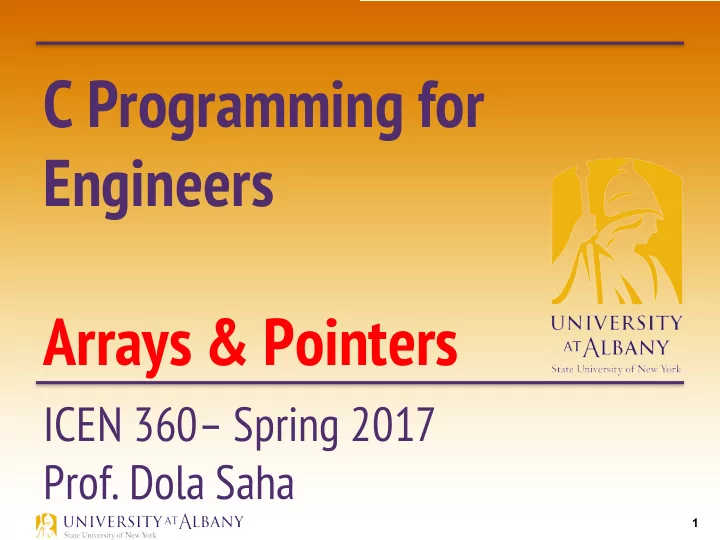

C Programming for Engineers Arrays & Pointers ICEN 360– Spring 2017 Prof. Dola Saha 1
Classroom Assignment Ø Matrix Addition/Subtraction – two matrices should have same number of rows and columns. Addition Subtraction https://en.wikipedia.org/wiki/Matrix_addition 2
Variable Length Array Ø In early versions of C, all arrays had constant size. Ø If size is unknown at compilation time § Use dynamic memory allocation with malloc Ø The C standard allows a variable-length array § An array whose length, or size, is defined in terms of an expression evaluated at execution time. 3
Variable Length Array Code (1) 4
Variable Length Array Code (2) 5
Variable Length Array Code (3) 6
Variable Length Array Code (4) 7
Variable Length Array Code (5) 8
Matrix Multiplication Ø If A is a 𝑜×𝑛 matrix and B is a 𝑛×𝑞 matrix, then Matrix Multiplication is given by following formula https://en.wikipedia.org/wiki/Matrix_multiplication 9
Matrix Multiplication - Illustrated 10
Random Number Generation Ø The rand function generates an integer between 0 and RAND_MAX (a symbolic constant defined in the <stdlib.h> header). § i = rand(); Ø To get a range of values, use remainder operation. § i = rand()%N; // random values in {0 to N-1} 11
Random Number Generation Code 12
Pseudorandom numbers Ø Function rand generates pseudorandom numbers. Ø Calling rand repeatedly produces a sequence of numbers that appears to be random. Ø Randomizing § A program conditioned to produce a different sequence of random numbers for each execution § Accomplished with the standard library function srand . Ø Function srand() takes an unsigned integer argument and seeds function rand() to produce a different sequence of random numbers for each execution of the program. 13
Randomizing with a seed 14
Randomize without providing a seed To randomize without entering a seed each time, use a statement like Ø srand(time( NULL)); The function prototype for time is in <time.h> . Ø 15
Classroom Assignment Ø Use Random Number generation to assign random values to two nxm matrices (A and B), then add / subtract the matrices and print the result matrix. 16
What does the code do? // ex06_18.c 1 // What does this program do? 2 #include <stdio.h> 3 #define SIZE 10 4 5 // function prototype 6 void someFunction( const int b[], size_t startIndex, size_t size); 7 8 // function main begins program execution 9 int main( void ) 10 { 11 int a[ SIZE ] = { 8 , 3 , 1 , 2 , 6 , 0 , 9 , 7 , 4 , 5 }; // initialize a 12 13 puts( "Answer is:" ); 14 someFunction(a, 0 , SIZE ); 15 puts( "") ; 16 } 17 18 // What does this function do? 19 void someFunction( const int b[], size_t startIndex, size_t size) 20 { 21 if (startIndex < size) { 22 someFunction(b, startIndex + 1 , size); 23 printf( "%d " , b[startIndex]); 24 } 25 } 26 17
Pointers Ø Pointers are variables whose values are memory addresses . Ø A variable name directly references a value, and a pointer indirectly references a value. Ø Referencing a value through a pointer is called indirection. 18
Declaring Pointers Pointers must be defined before they can be used. Ø The definition Ø int *countPtr, count; o specifies that variable countPtr is of type int * (i.e., a pointer to an integer). The variable count is defined to be an int , not a pointer to an Ø int . 19
Initializing Pointers Ø Pointers should be initialized when they’re defined or they can be assigned a value. Ø A pointer may be initialized to NULL, 0 or an address. Ø A pointer with the value NULL points to nothing . Ø NULL is a symbolic constant defined in the <stddef.h> header (and several other headers, such as <stdio.h>). Ø Initializing a pointer to 0 is equivalent to initializing a pointer to NULL , but NULL is preferred. Ø When 0 is assigned, it’s first converted to a pointer of the appropriate type. Ø The value 0 is the only integer value that can be assigned directly to a pointer variable. 20
Pointer Operator The & , or address operator, is a unary operator that returns the Ø address of its operand. Example definition Ø int y = 5; o int *yPtr; the statement yPtr = &y; o assigns the address of the variable y to pointer variable yPtr . Variable yPtr is then said to “point to” y. Ø Graphical Representation Memory Representation 21
Indirection (*) Operator Ø The unary * operator, commonly referred to as the indirection operator or dereferencing operator, returns the value of the object to which its operand (i.e., a pointer) points. Ø Example: o printf( "%d", *yPtr); prints the value of variable that yPtr is pointing to In this case it is y , whose value is 5. Ø Using * in this manner is called dereferencing a pointer. 22
Using & and * 23
Pass by value 24
Pass by reference – simulating with Pointer 25
Pass by value (1) 26
Pass by value (2) 27
Pass by value (3) 28
Pass by reference (1) 29
Pass by reference (2) 30
Recommend
More recommend